If you have an old and heavy candle holder in your attic, you are sitting on a gem without even knowing it! Vintage candle holders are hot collectibles today, with some rare pieces fetching up to $5,000.
This detailed guide is about finding such valuable antique candle holders. You’ll learn to identify authentic pieces by styles, designs, and materials, and understand what makes certain holders more valuable than others, along with 8 rare pieces worth finding now!
Identifying Antique Candle Holders (5 Key Signs)
Candle holders have been around for thousands of years. The earliest ones were basically just wooden blocks with iron spikes stuck in them. By the 1600s, Brass became the go-to material because it lasted forever.
The 1700s? That’s when candle holders really took off. Georgian craftsmen started making them hollow instead of solid, which meant they could add cool features like push-rod ejectors.
Victorian times (1800s) changed everything. Suddenly, middle-class families could afford nice candle holders thanks to mass production. Manufacturers went crazy with materials — silver plate, brass, glass, ceramics, you name it.
In short, many things change over the years, from material to design and construction. So, to spot an authentic antique candle holder, you need to assess these aspects. Here’s what to spot:
Types of Candle Holders
Not all candle holders are created equal. Here are the most common types you may come across:
- Candlesticks – Your basic single-candle holder. But don’t let that fool you. These can range from plain brass sticks to elaborate silver pieces that’ll make your jaw drop.
- Chambersticks – Picture this: You’re wandering through a dark hallway in 1850. What do you carry? A chamberstick! They’ve got a round base with a handle. Many even have built-in snuffers (those little cone things for putting out candles).
- Candelabras – These are the show-offs with multiple arms, multiple candles, maximum drama. The menorah is probably the most famous example, but there are tons of other styles.
- Fairy Lamps – Okay, these are adorable. Small glass lamps from about 135 years ago, often in gorgeous colors. They’re like the nightlights of the Victorian era.
- Pricket Holders: Old-school types with spikes to hold candles (before standard sizes were a thing).
- Wall Sconces – These mount on the wall and often come in pairs. By the 1700s, they were getting super elaborate with multiple tiers of candles. Talk about mood lighting!
Styles & Designs
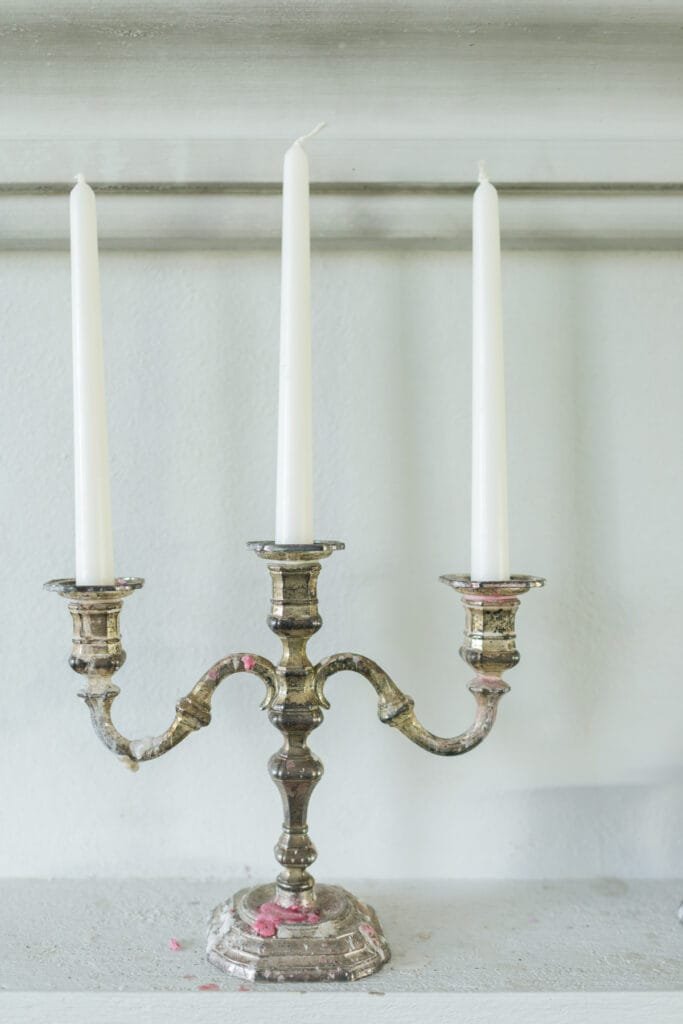
Candle holders made in different eras had different vibes in terms of how they looked. Here’s a breakdown of the most common styles with their key features:
Baroque Style (1600-1750):
If your candle holder looks like it belongs in Versailles, it’s probably Baroque:
- Key Features: Swirling, twisting forms that seem to dance
- Common Motifs: Acanthus leaves, cherubs, scrollwork, shells
- Overall Feel: Heavy, dramatic, theatrical, over-the-top
- Materials: Silver, gilded bronze (ormolu), sometimes brass
- Proportions: Robust, substantial, often top-heavy
Rococo Style (1730-1770):
Rococo pieces look more abstract with their uneven designs and playfulness.
- Key Features: Asymmetrical designs, delicate curves, playful elements
- Common Motifs: Shells (rocaille), flowers, ribbons, pastoral scenes
- Overall Feel: Light, feminine, flirtatious, whimsical
- Materials: Silver, porcelain, gilded bronze
- Proportions: More delicate than Baroque, better balanced
Neoclassical Style (1760-1830):
These pieces appear to be inspired by Greek history:
- Key Features: Straight lines, perfect symmetry, geometric shapes
- Common Motifs: Laurel wreaths, urns, columns, Greek key patterns
- Overall Feel: Formal, balanced, refined, intellectual
- Materials: Silver, Sheffield plate, ormolu
- Proportions: Well-balanced, architectural feel
Empire Style (1800-1815):
If you’re noticing a lot of eagles and victory figures, it’s probably an Empire-style candle holder:
- Key Features: Bold classical elements, military themes
- Common Motifs: Eagles, winged victories, torches, stars, bees (Napoleon’s symbol)
- Overall Feel: Imperial, masculine, powerful, formal
- Materials: Bronze, ormolu, and marble bases are common
- Proportions: Sturdy, monumental feeling despite size
Victorian Style (1837-1901):
Victorian candle holders are heavily decorated, with multiple style influences in one piece:
- Key Features: Mix of revival styles, maximum ornamentation
- Common Motifs: Flowers, angels, Gothic arches, Renaissance scrolls, animals
- Overall Feel: Busy, eclectic, sentimental, luxurious
- Materials: Everything – brass, bronze, silver-plate, glass, ceramic
- Proportions: Varies widely, often heavy and ornate
Art Nouveau Style (1890-1910):
See a lot of curves and flowing motifs on a candlestick? You’re most likely holding an Art Nouveau piece:
- Key Features: Flowing organic lines, nature-inspired forms
- Common Motifs: Stylized flowers, vines, female figures, dragonflies, peacocks
- Overall Feel: Sensual, dreamlike, fluid, naturalistic
- Materials: Bronze, pewter, colored glass, copper
- Proportions: Elongated, sinuous, often asymmetrical
Art and Crafts Style (1880-1920):
Candle holders with minimal decoration are of Art Deco style:
- Key Features: Simple forms, visible construction, handmade quality
- Common Motifs: Geometric flowers, hammered surfaces, honest joinery
- Overall Feel: Sturdy, honest, unpretentious, functional
- Materials: Copper, brass, oak, wrought iron
- Proportions: Solid, well-balanced, often square or rectangular bases
Construction Clues
Construction methods are like fingerprints — they tell you when and how something was made.
- Cast Construction: Metal poured into molds. Look for mold seams, especially on less expensive pieces. High-end pieces had seams filed smooth.
- Wrought Construction: Hand-forged, usually iron. These typically show hammer marks and irregularities. Common in early pieces and the Arts and Crafts revival.
- Assembled Construction: Parts are made separately and then joined together. Check joints for solder or screws. Victorian pieces often have multiple parts screwed together.
- Turned Construction: Made on a lathe, these holders show concentric circles. Common for wooden pieces and some metal stems.
- Stamped/Pressed Construction: Thin metal pressed into the final holder shape. Commonly seen in later Victorian and 20th-century pieces. Typical examples are usually lighter weight than cast pieces.
Maker’s Marks

Maker’s marks and stamps on a vintage candle holder are like signatures that can tell you who made it, where it was made, when it was made, and what it’s made of!
Types of Marks You’ll Find:
- Maker’s marks (initials, symbols, full names)
- Assay marks (metal purity)
- Date letters (especially British silver)
- Patent numbers (great for dating American pieces)
- Registry marks (British diamond-shaped marks)
Where to look for marks? Well, the companies like to mark their holders on the underside of the base (most common), inside the cup/socket, along the stem, or on removable parts, such as bobeches and drip pans.
Note: Be aware — some brass and pewter pieces have decorative marks that look official but aren’t. These are just decorations, not actual hallmarks.
Materials & Their Identification
Material identification is crucial for dating and valuing pieces. Here’s your material cheat sheet:
- Silver: Authentic vintage silver candle holders are typically marked! Look for hallmarks — tiny stamps that tell you purity, maker, and date. Sterling silver is marked with “.925” or “sterling.” British pieces have their complex hallmark system with lions, date letters, and maker’s marks.
- Sheffield Plate: Silver sandwich — thin silver layers fused to copper. Popular from the 1740s to the 1840s. Look for copper showing through worn spots. Earlier pieces have visible seams; later ones are seamless.
- Silver Plate: Different from Sheffield plate — this is base metal electroplated with silver. Common after 1840. Common marks found on these pieces are “EPNS” (Electroplated Nickel Silver), “silver plate,” “EP” (electroplate), “A1”, or “AA”.
- Brass: The workhorse material. Used throughout history, it develops a warm patina with age. Victorian brass is often lacquered (shiny), while earlier pieces have a duller finish. Test with a magnet — brass isn’t magnetic.
- Bronze: Heavier than brass, often used for high-end pieces. Develops a distinctive greenish patina over time. French bronze candle holders are especially prized. Also non-magnetic.
- Pewter: Soft, gray metal that darkens with age. Popular in America and Northern Europe. These often have maker’s touchmarks. Be careful — it dents easily.
- Glass: From simple pressed glass to elaborate cut crystal. Depression glass candle holders in colors are highly collectible. Crystal has lead content, making it heavier and more brilliant than regular glass.
- Porcelain and Pottery: Meant for decorative candle holders, often hand-painted or molded with intricate designs. Look for maker’s marks on the base.
What Makes Old Candle Holders Valuable?
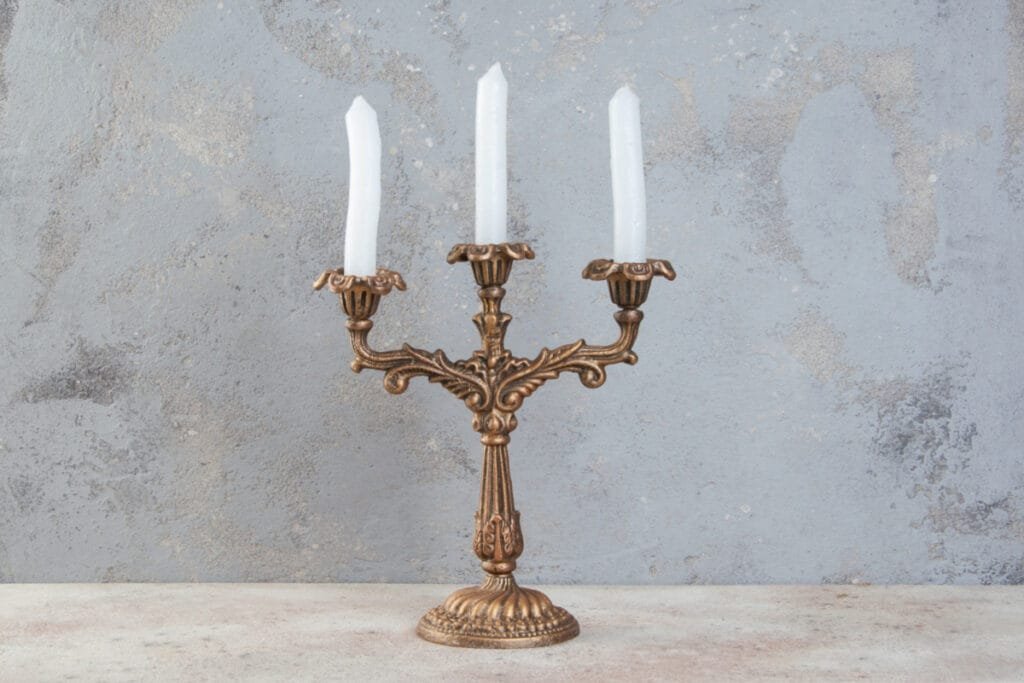
Now for the million-dollar question (sometimes literally): how do you know if an antique candle holder is worth just a few bucks or more? The value depends on several factors:
Condition and Completeness
Condition profoundly affects an antique candle holder’s value, but not always in the way you’d expect. Yes, pristine holders command top dollar, but honest wear that proves authenticity is actually desirable.
What kills value is serious damage like cracks, poor repairs, or missing parts. Heavy polishing is another value killer – it removes the patina that took centuries to develop and can even wear away fine details.
Completeness also matters enormously. A single candlestick might be worth $100, but if you find its mate to make a pair, the combined value could jump to $500 or more.
Besides, original accessories like snuffers, shades, or drip pans (called bobeches) add significant value. Finding a complete set – say, a pair of candelabra with matching single candlesticks – is like hitting the collector’s lottery.
Material Matters
The material of a candle holder can make or break the deal! Here are some most common materials and their impact on values:
- Sterling Silver: The gold standard (pun intended). Good Sterling Silver pieces start around $500 and can hit thousands for special examples.
- Sheffield Plate: This is an early form of silver plating (sheets of silver fused to copper)! Not solid silver, but these can still fetch $100-$500 for nice pieces.
- Brass and Bronze: All about the artistry. Simple ones might be $50, but elaborate designs can hit $500 to $2,000 or more!
- Pewter: Antique pewter pieces, especially early examples with clear maker’s marks, can fetch good returns: from $50 to $300 or more on average!
- Glass: Varies wildly. Tiffany? Thousands. Pretty pressed glass? Maybe $20-$100.
- Porcelain: Big names like Meissen command big prices. Lesser-known makers, not so much.
Special Features that Add Value
Some special features can make a regular candle holder a collector’s charm. Here are a few things that actually matter:
- Hand engraving
- Figural designs (cherubs, animals)
- Complete sets with shades or prisms
- Working mechanical parts
- Famous estate provenance
- Unusual patents or mechanisms
Rare Examples of Vintage Candle Holders Worth Money
1. Antique Tiffany Studios Brass Candle Stick Holder

One of the most expensive vintage candle holders I found! This one is an iconic Tiffany Studios piece, made of solid bronze. The green glasswork set into the bronze frame is a classic Tiffany technique.
This substantial piece stands 14.75 inches tall with its elegant and sleek design. The bottom marking “Tiffany Studios/New York,” along with some numbers, authenticates this vintage Tiffany piece. The large size, excellent condition, and Tiffany’s branding make this candle holder worth $1000-$3,000!
2. French Ormulu Candle Holder
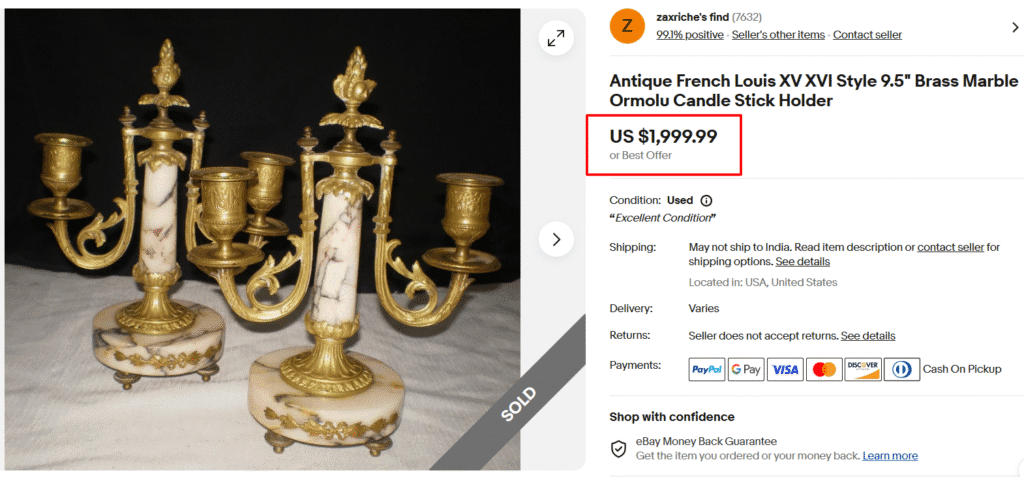
This French ormolu holder is an absolute showpiece, sold at almost $2,000! “Ormolu” refers to fire-gilded bronze – a luxury decorative technique where ground gold is applied to bronze and heated to create a permanent gold surface.
Standing 9.5 inches, the holders are more of table centerpieces than the towering Dutch candlesticks. The ornate rococo-style scrolling arms, decorative finials, and the combination of white marble columns with gilt bronze mounts are pure French elegance.
3. Meissen Porcelain Figurine Candle Stick
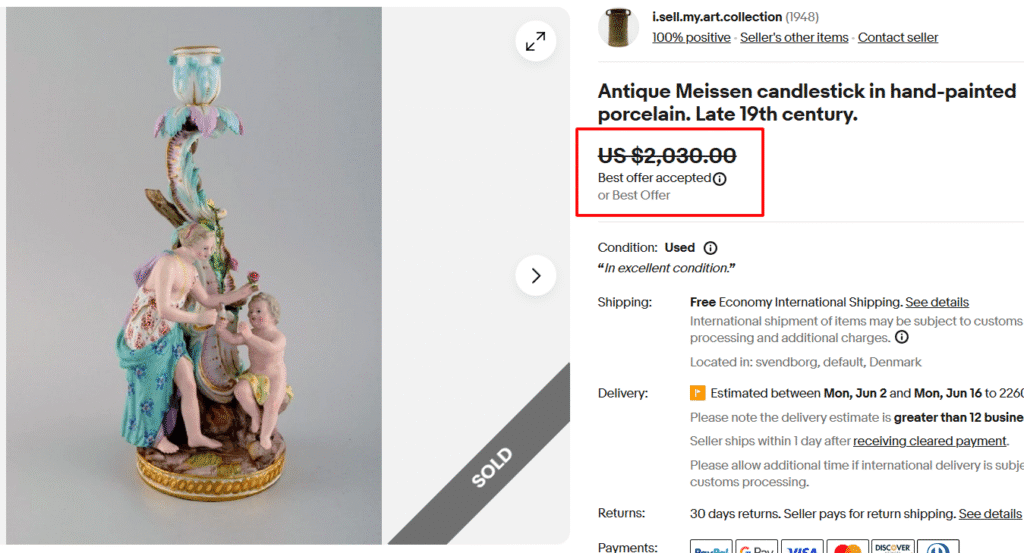
This is the crown jewel of the collection, priced at $2,030, because Meissen is the Rolls-Royce of European porcelain! This late 19th-century candle holder features their signature hand-painted decoration with figures, which required master artisans to create.
The mythological or pastoral scene is typical of Meissen’s romantic style. Vintage Meissen candle holders can range from hundreds to tens of thousands, depending on age, complexity, and condition.
4. Antique Forged Wrought Iron Floor Candle Holder
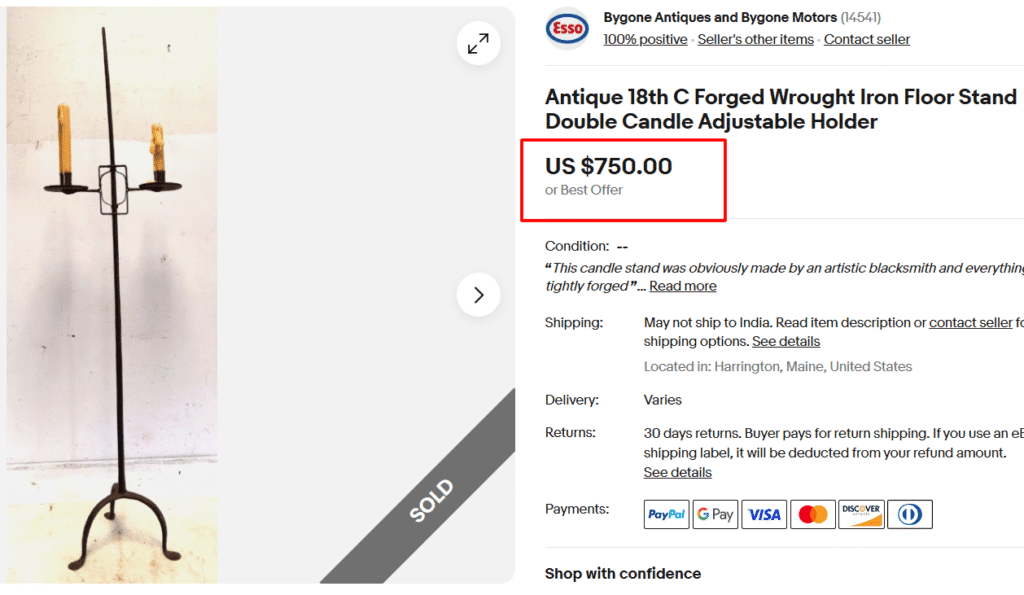
This is a substantial piece of American folk art from the 1700s. What makes it special is that it’s clearly handmade by a skilled blacksmith – you can see the artistic touches in the twisted metalwork and the adjustable double-arm design.
Sold at $750, this piece is priced fairly for genuine 18th-century American metalwork. These floor-standing candelabras were practical lighting fixtures in colonial homes, and finding one in solid condition is increasingly rare!
5. Dutch Brass Heemskerk Candlesticks
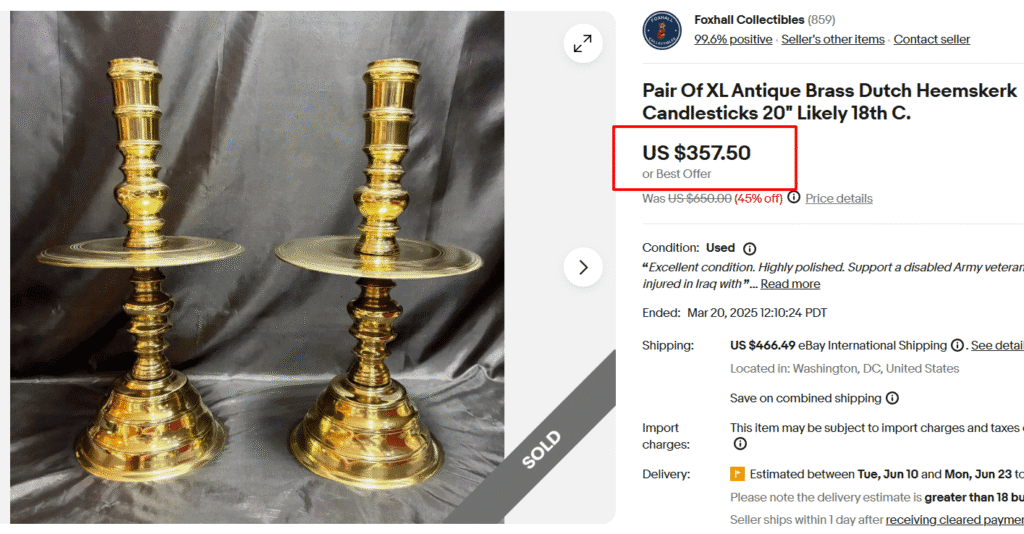
This pair of 20-inch tall brass candlesticks is a significant find. It features the iconic Heemskerk style, referring to brass candlesticks produced in Heemskerk, Netherlands, which was famous for its brass foundries in the 17th and 18th centuries.
What’s remarkable about these pieces is their size – at 20 inches, they’re substantial altar-style candlesticks. The multiple rings and bulbous turnings are classic Dutch design elements from this period, and the full brass body makes these sticks worth the $357 price tag. Similar examples can easily sell for $200-$600!
6. Antique Baccarat Hurricane Crystal Candlesticks
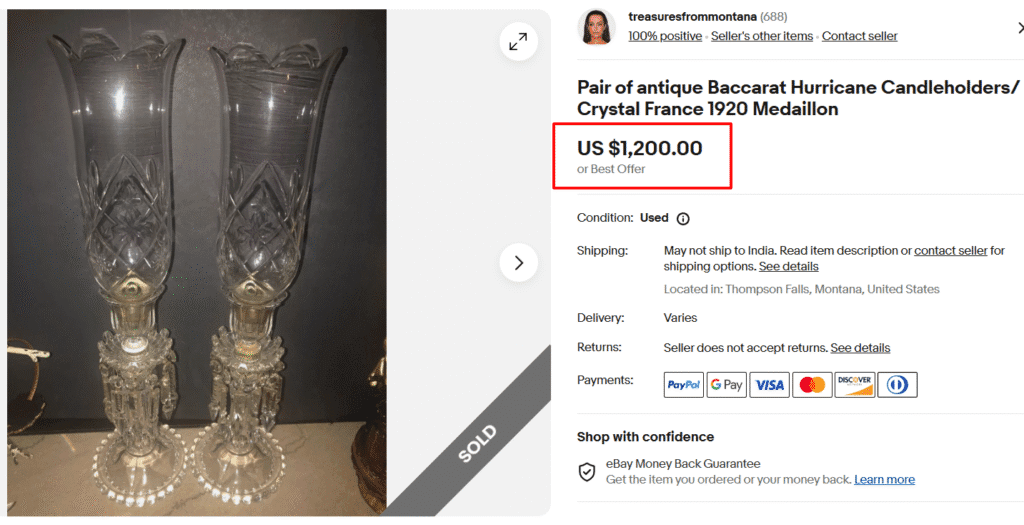
This is an example of the French luxury crystal at its finest. Baccarat has been making crystal since 1764 and is known for exceptional clarity and cutting. The neatly cut “Medaillon” pattern from the 1920s (on the bottom) places these candlesticks in the Art Deco era!
Hurricane lamps like these protected candle flames while amplifying light through the crystal. The pricing is actually moderate for authenticated Baccarat pieces in good condition – similar pairs can fetch $2,000-3,000 at auction!
7. Etain French Pewter Wall Sconce Candle Holder
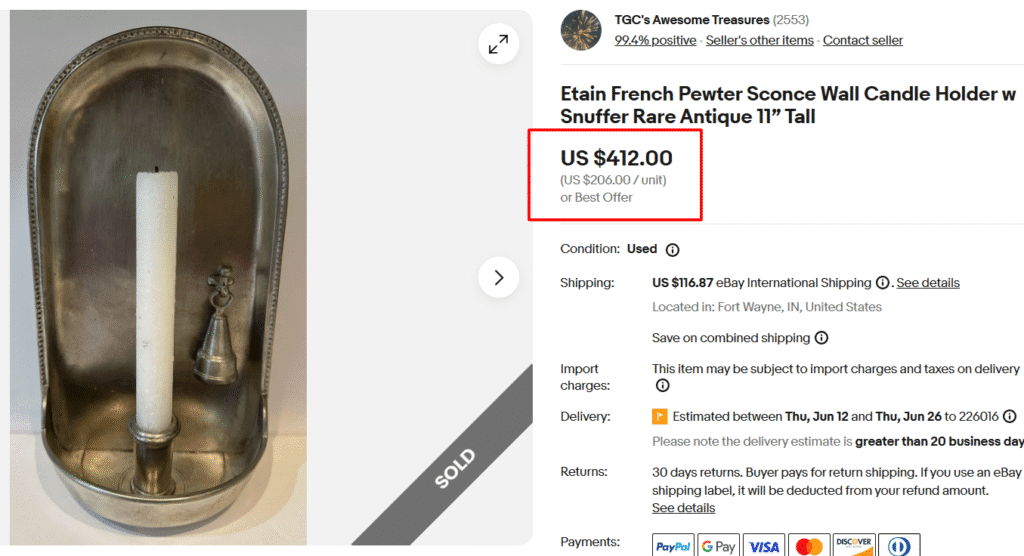
These antique French pewter sconces from Etain are intriguing for collectors! Although it has a solid, plain design with a simple beaded edge, what’s more interesting about this piece is the included snuffer – a practical touch that authentic period candle holders typically have.
French pewter holders from the 19th century are collectible, though not as valuable as earlier pieces. If you find one in decent condition, it can fetch $200-$500 at sales.
8. Westmoreland Milk Glass Candle Holders
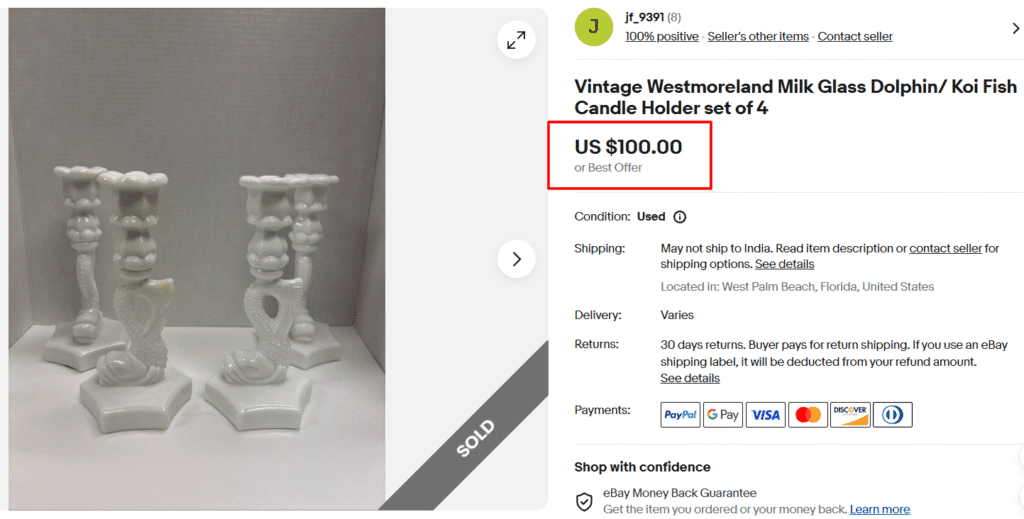
Westmoreland Glass Company was an American manufacturer that operated from 1889 to 1984, making quality milk glass pieces that are now vintage collectibles. These dolphin or koi fish candle holders show Westmoreland’s decorative approach to functional items.
You can spot them by the delicate, highly detailed glasswork with curves and shapes, along with a sturdy design. Vintage Westmoreland milk glass pieces have a dedicated collector base, which justifies the $100 price tag for this piece!
Note: This article is intended for informational, educational, and entertainment purposes only. Some images are illustrative and may not represent actual brands, products, or related entities. All trademarks, product names, brand logos, packaging, and other intellectual property referenced remain the exclusive property of their respective owners. Any brand mentions or references are provided solely for descriptive and educational context and do not imply any formal or commercial association.


